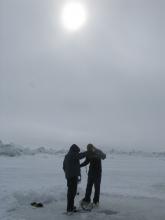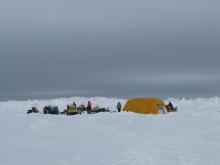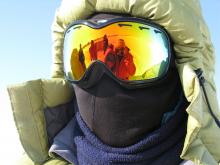Update
Lollie is back in the Arctic and had two trips to Barrow, Alaska in 2011. The first trip was January 23 to February 2 and the second trip was April 24 to May 1. Besides through her PolarTREC journals, you can also learn more about this field work through the project website, Arctic Nitro here!
What Are They Doing?
The research team sampled the coastal waters of the Arctic Ocean to investigate how microbial creatures affect the productivity of a coastal Arctic ecosystem. They traveled to the field site via snowmobile and sampled the seawater through a hole drilled into the sea ice. The seawater collected was used to look at competition between autotrophs, organisms that make their own food, and heterotrophs, organisms that cannot make their own food, and for nitrogen (N) in the waters near Barrow, Alaska.
The field work took place over the course of three seasons (two years) to give researchers the opportunity to investigate the coastal water ecosystems in different seasons, winter and summer, and with different amounts of daylight. The sources of nitrogen vary when there is no daylight in the winter, from the summer where there is nearly 24 hours of daylight.
In ocean ecosystems, microbes dominate many of the processes and are the major producers and consumers of carbon dioxide (CO2) and other greenhouse gases. Understanding the role of microbial communities in the Arctic ecosystem is an essential part of predicting the impact of climate change on Arctic food webs and other natural cycles.
Where Are They?
The research team was stationed at the Barrow Arctic Science Consortium also known as BASC. They traveled to sampling sites on the sea ice by snowmobile during the dark arctic day. Weather conditions were challenging as they traveled to the ice edge of the Arctic Ocean.
Barrow is located on Alaska’s North Slope near the shoreline of the Arctic Ocean. Barrow is a small community of approximately 4,500 people. The climate is arctic, with the daily minimum temperature dropping below freezing 300 days a year and 24 hours of darkness during the winter months. The community is primarily inhabited by Inupiat Eskimos, and is not accessible by road.
Latest Journals

Dr. Patricia (Tish) Yager is an associate professor in marine sciences at the University of Georgia. Her expertise includes biological and chemical oceanography, marine microbial ecology and biogeochemistry. Her research focuses on the feedbacks between climate change and marine ecosystems. Her field research combines microbial ecology and community structure with inorganic carbon chemistry. She has spent several seasons working in Antarctica, and also studies microbial communities in the Amazon River. For the project in Barrow, Alaska, Tish will be the lead-PI responsible for project oversight, coordination, and synthesis. To learn more about Dr. Yager, please visit her faculty biography page.

Research in Dr. Marc Frischer's laboratory focuses on the role of microbial diversity in marine environments, the development and application of the tools of molecular biology in plankton ecology, and the discovery and ecology of parasite and pathogens in marine organisms. The impact and consequences of climate change on living marine systems focuses much of the ongoing research in the Frischer research group. A large emphasis is placed on the development and evaluation of new methods, particularly those that can be used in situ. In addition, a focus of the Frischer laboratory is the adaptation of molecular biological tools to a wide variety of questions in applied marine sciences, biotechnology, bioremediation, and invasive species issues.

The Bronk group is focusing on defining the competition between phytoplankton and bacteria for available nitrogen. As part of our study, we are doing experiments with humics, which are the tea colored compounds that run off the land when permafrost melts. These humics can decrease the amount of light in the water, which phytoplankton need, while providing a source of carbon, which bacteria require. As the permafrost melts, we hypothesize that bacteria will be able to outcompete phytoplankton for nitrogen more often.





